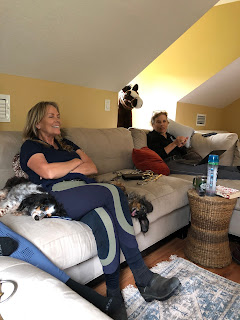April 14: A Bit about Bits
Rainy morning, so we had a Theory Day, while Toby dried off in a stall with hay to munch. The theme was “bits.”
A direct contact bit (e.g., a snaffle) is used for lateral flexion and power (which comes from horse taking the bit. Also allows for horse to become round in back and flex.) Considered “direct” because when you apply pressure to the reins of a snaffle bit, the horse feels the same amount of pressure in their mouth.
[Note: The Parelli Cradle bridle/bit is designed to softly “cradle” the horse’s head with 5 points of contact. On the bit, the option of using the small ring is more of an indirect contact, where the large ring option offers the direct contact option (which is what I use with Toby.)]
Different horsenalities frequently have a bit preference.
MOVERS: Like a Loose Ring bit because they have a problem with being restricted and a loose ring gives more freedom in their mouth. Be sure to not have bit too small though … want to avoid pinching them when the ring moves.
STOPPERS: Prefer a Fixed Cheek bit, as they tend to not like a bit with lots of movement … like stability and precision ofn a Fixed Cheek
PUSHY: Like a bit with a tongue release, so they can find a place that is comfortable for their tongue and not have tongue restricted.
TENSE: Like a bit that has tongue contact. They like the stable feel of a comfortable hug in the mouth.
It is preferable to have a bit with an oval piece, which sits in the center of the mouthpiece, joining the two halves of the bit together. This is called a lozenge, which is smooth, and applies moderate pressure to the center of the tongue. It avoids pinching their mouth when both reins are picked up.
We looked at a variety of bits, as we discussed their purpose and horse’s preferences. Also, when you might change bits … e.g., start a young horse with one kind of bit and switch to a different bit as a horse advances in its training/competing.
For more information about bits, check out Neue Schule bits, which have a lot of research behind their product line. Website is https://nsbits.com
I rode in the afternoon and practiced bending exercises and leg yields. Also, more tarp practice. Toby is getting more confident, as I become a better leader.





Comments
Post a Comment